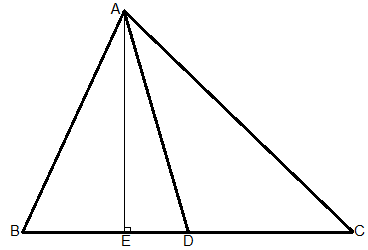
Show that a median of a triangle divides it into two triangles of equal area.
Answer
505.3k+ views
Hint: To prove, we draw a median to the given triangle. We use the definition of median. Then we’ll have two triangles with a common vertex and bases of equal length. Find the area of one triangle and show it is equal to the other.
Complete Step-by-Step solution:

Let ABC be a triangle.
Let AD be one of its medians.
∆ABD and ∆ADC have the vertex A in common.
Hence, the bases BD and DC are equal (as AD is the median).
Now, draw a line AE perpendicular to BC, AE ⊥ BC.
We know the area of a triangle with base b and height h is = $\dfrac{1}{2} \times {\text{b}} \times {\text{h}}$
Now area of triangle ∆ABD = $\dfrac{1}{2} \times {\text{base}}$× altitude of ∆ABD
= $\dfrac{1}{2} \times {\text{BD}} \times {\text{AE}}$
= $\dfrac{1}{2} \times {\text{DC}} \times {\text{AE}}$ --- (Since BD = DC)
But DC and AE are the base and altitude of ∆ACD respectively.
Area of ∆ACD = $\dfrac{1}{2}$× base DC × altitude of ∆ACD
= $\dfrac{1}{2} \times {\text{DC}} \times {\text{AE}}$
Hence, area of (∆ABD) = area of (∆ACD)
Hence the median of a triangle divides it into two triangles of equal areas.
Note – The key in such problems is to draw a figure and include a median in it. This makes the figure into two triangles with a common vertex and equal bases.
Finding the area of one triangle and using the condition of equal bases gives us the proof.
(In geometry, a median of a triangle is a line segment joining a vertex to the midpoint of the opposite side, thus bisecting that side.)
Complete Step-by-Step solution:

Let ABC be a triangle.
Let AD be one of its medians.
∆ABD and ∆ADC have the vertex A in common.
Hence, the bases BD and DC are equal (as AD is the median).
Now, draw a line AE perpendicular to BC, AE ⊥ BC.
We know the area of a triangle with base b and height h is = $\dfrac{1}{2} \times {\text{b}} \times {\text{h}}$
Now area of triangle ∆ABD = $\dfrac{1}{2} \times {\text{base}}$× altitude of ∆ABD
= $\dfrac{1}{2} \times {\text{BD}} \times {\text{AE}}$
= $\dfrac{1}{2} \times {\text{DC}} \times {\text{AE}}$ --- (Since BD = DC)
But DC and AE are the base and altitude of ∆ACD respectively.
Area of ∆ACD = $\dfrac{1}{2}$× base DC × altitude of ∆ACD
= $\dfrac{1}{2} \times {\text{DC}} \times {\text{AE}}$
Hence, area of (∆ABD) = area of (∆ACD)
Hence the median of a triangle divides it into two triangles of equal areas.
Note – The key in such problems is to draw a figure and include a median in it. This makes the figure into two triangles with a common vertex and equal bases.
Finding the area of one triangle and using the condition of equal bases gives us the proof.
(In geometry, a median of a triangle is a line segment joining a vertex to the midpoint of the opposite side, thus bisecting that side.)
Recently Updated Pages
Master Class 12 Economics: Engaging Questions & Answers for Success

Master Class 12 Maths: Engaging Questions & Answers for Success

Master Class 12 Biology: Engaging Questions & Answers for Success

Master Class 12 Physics: Engaging Questions & Answers for Success

Master Class 8 Maths: Engaging Questions & Answers for Success

Class 8 Question and Answer - Your Ultimate Solutions Guide

Trending doubts
Why is there a time difference of about 5 hours between class 10 social science CBSE

Write a letter to the principal requesting him to grant class 10 english CBSE

What is the median of the first 10 natural numbers class 10 maths CBSE

The Equation xxx + 2 is Satisfied when x is Equal to Class 10 Maths

Which of the following does not have a fundamental class 10 physics CBSE

State and prove converse of BPT Basic Proportionality class 10 maths CBSE




